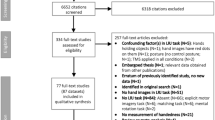Abstract
The present study examined the accuracy of proprioceptive localization of the hand using two paradigms. In our proprioceptive estimation paradigm, participants judged the position of a target hand relative to visual references, or their body’s midline. Placement of the target hand was active (participants pushed a robot manipulandum along a constrained path) or passive (the robot manipulandum positioned participants’ target hand). In our proprioceptive-guided reaching paradigm, participants reached to the unseen location of a hand; both the left and right hands served as the target hand and the reaching hand. In both paradigms, subjects were relatively good at estimating the location of each hand (i.e. relative to a reference marker or using a reach), with directional errors falling within 2 cm of the actual target location, and little variation across the workspace. In our proprioceptive estimation paradigm, biases when the target hand was passively placed were no larger than those made when the target hand was actively placed. Participants perceived their left hand to be more to the left than it actually was, and their right hand to be more rightward than it actually was, but with a similar error magnitude across target hands. In our reaching paradigm, participants’ estimates of left hand location were deviated more leftwards than their estimates of right hand location, but showed a small but similar pattern of location-dependent reach errors across the two hands. Precision of estimates did not differ between the two hands or vary with target location for either paradigm.





Similar content being viewed by others
References
Adamovich SV, Berkinblit MB, Fookson O, Poizner H (1998) Pointing in 3D space to remembered targets I. Kinesthetic versus visual target presentation. J Neurophysiol 79:2833–2846
Blangero A, Rossetti Y, Honore J, Pisella L (2005) Influence of gaze direction on pointing to unseen proprioceptive targets. Adv Cogn Psychol 1:9–16
Boulinguez P, Nougier V, Velay J-L (2001) Manual asymmetries in reaching movement control I: study of right handers. Cortex 37:101–122
Carson RG, Elliot D, Goodman D, Dickson J (1990) Manual symmetries in the reproduction of a 3-dimensional spatial location. Neuropsychologia 28:99–103
Crowe A, Keesen W, Kuus W, Van Vliet R, Zegeling A (1987) Proprioceptive accuracy in two dimensions. Percept Mot Skills 64:831–846
Dijkerman CH, de Haan (2007) Somatosensory processes subserving perception and action. Behav Brain Sci 30:189–239
Fitts PM (1966) Cognitive aspects of information processing III: set for speed versus accuracy. J Exp Psychol 71:849–857
Ghilardi MF, Gordon J, Ghez C (1995) Learning a visuomotor transformation in a local area of work space produces direction biases in other areas. J Neurophysiol 73:2535–2539
Goble DJ, Lewis CA, Brown SH (2006) Upper limb asymmetries in the utilization of proprioceptive feedback. Exp Brain Res 168:307–311
Goodale MA, Milner AD (1992) Separate visual pathways for perception and action. Trends Neurosci 15:20–25
Haggard P, Newman C, Blundell J, Andrew H (2000) The perceived position of the hand in space. Percept Psychophys 68:363–377
Henriques DYP, Soechting JF (2003) Bias and sensitivity in the haptic perception of geometry. Exp Brain Res 150:95–108
Hodges NJ, Lyons J, Cockell D, Reed A, Elliott D (1997) Hand, space, and attentional asymmetries in goal-directed manual aiming. Cortex 33:251–269
Kesten H (1958) Accelerated stochastic approximation. Ann Math Stat 29:41–59
Laufer Y, Hocherman S, Dickstein R (2001) Accuracy of reproducing hand position when using active compared with passive movement. Physiother Res Int 6:65–75
Lovelace EA (1989) Vision and kinesthesis in accuracy of hand movement. Percept Mot Skills 68:707–714
Milner AD, Goodale MA (1995) The visual brain in action. Oxford University Press, Oxford
Mishkin M (1979) Analogous neural models for tactual and visual learning. Neuropsychologia 17:139–151
Paillard J, Brouchon M (1968) Active and passive movement in the calibration of position sense. In: Freedman SJ (Ed) The neuropsychology of spatially oriented behavior. Dorsey, Homewood, pp 35–55
Pouget A, Ducom JC, Torri J, Bavelier D (2002) Multisensory spatial representations in eye centered coordinates for reaching. Cognition 83:B1–B11
Sarlegna FR, Sainburg RL (2007) The effect of target modality on visual and proprioceptive contributions to the control of movement distance. Exp Brain Res 176:267–280
Treutwein B (1995) Adaptive psychophysical procedures. Vis Res 17:2503–2522
van Beers RJ, Sittig AC, Denier van der Gon JJ (1998) The precision of proprioceptive position sense. Exp Brain Res 122:367–377
Wang J, Sainburg RL (2007) The dominant and nondominant arms are specialized for stabilizing different features of task performance. Exp Brain Res 178:565–570
Wann JP (1991) The integrity of visual-proprioceptive mapping in cerebral palsy. Neuropsychologia 29:1095–2106
Wong T, Henriques DY (2009) Visuomotor adaptation does not recalibrate kinesthetic sense of felt hand path. J Neurophysiol 101:614–623
Author information
Authors and Affiliations
Corresponding author
Rights and permissions
About this article
Cite this article
Jones, S.A.H., Cressman, E.K. & Henriques, D.Y.P. Proprioceptive localization of the left and right hands. Exp Brain Res 204, 373–383 (2010). https://doi.org/10.1007/s00221-009-2079-8
Received:
Accepted:
Published:
Issue Date:
DOI: https://doi.org/10.1007/s00221-009-2079-8




